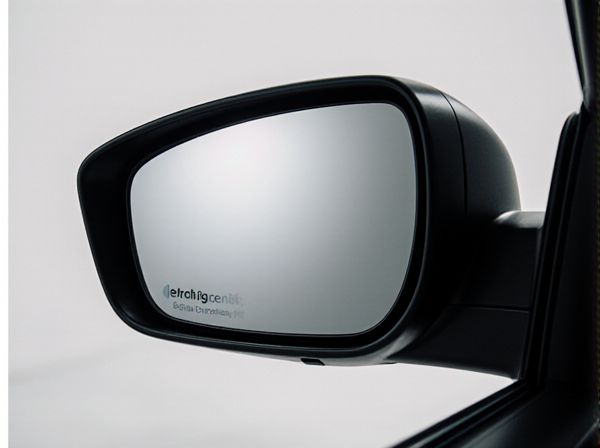
Photo illustration: Electrochromatic Mirror vs Manual Dimming Mirror
Electrochromatic mirrors automatically adjust their tint based on ambient light, reducing glare without requiring any effort from you. Manual dimming mirrors need to be adjusted by hand, which can be inconvenient and less precise in quickly changing light conditions. Choosing an electrochromatic mirror enhances driving comfort and safety, especially during night-time or bright light conditions.
Table of Comparison
| Feature | Electrochromatic Mirror | Manual Dimming Mirror |
|---|---|---|
| Operation | Automatic dimming via electronic sensors | Manual dimming by flipping a lever |
| Glare Reduction | Adaptive and continuous glare control | Fixed-level glare reduction |
| Convenience | Hands-free, auto-adjusts to lighting conditions | Requires manual adjustment |
| Cost | Higher purchase and maintenance cost | Lower cost and simpler design |
| Technology | Uses electrochromic gel and sensors | Basic reflective mirror with dimming lever |
| Durability | Potential electronic failure over time | Simple mechanical parts, longer reliability |
| Typical Usage | Premium and modern vehicles | Entry-level and older model vehicles |
Understanding Electrochromatic Mirrors
Electrochromatic mirrors utilize a light sensor and an electrochromic gel layer to automatically reduce glare from headlights, enhancing nighttime driving safety by dimming the mirror surface without manual intervention. Unlike manual dimming mirrors, which require physical adjustment via a tab or lever, electrochromatic mirrors intelligently adjust based on ambient light conditions, providing consistent glare reduction and increased driver comfort. This advanced technology improves visibility and reduces eye strain, making it a superior choice for modern vehicles focused on safety and convenience.
What Is a Manual Dimming Mirror?
A manual dimming mirror features a pivoting tab or lever that drivers adjust to reduce glare from headlights at night, enhancing visibility and driving comfort. Unlike electrochromatic mirrors, which automatically darken using an electronic sensor and electrochromic technology, manual dimming mirrors require physical manipulation to change the mirror's tint. This traditional design offers a cost-effective solution but lacks the convenience and automatic glare reduction found in electrochromatic mirrors.
Key Differences in Technology
Electrochromatic mirrors use electronic sensors and electrochromic gel to automatically adjust reflectivity based on ambient light, reducing glare more precisely and instantly. Manual dimming mirrors rely on a physical lever that the driver adjusts to change the mirror's angle, which darkens reflection by redirecting the light without electronic intervention. The advanced sensors and automation in electrochromatic mirrors provide enhanced convenience and safety compared to the manual, driver-dependent dimming mechanism.
How Each Mirror Enhances Safety
Electrochromic mirrors enhance safety by automatically adjusting tint in response to glare from headlights, reducing eye strain and improving night driving visibility. Manual dimming mirrors require drivers to physically adjust the mirror to reduce glare, which can momentarily distract them and reduce reaction time. The automatic feature of electrochromic mirrors maintains consistent visibility without driver intervention, leading to safer driving conditions, especially in low-light environments.
User Experience: Convenience and Ease of Use
Electrochromatic mirrors automatically adjust brightness to reduce glare from headlights, enhancing nighttime driving comfort without manual intervention. Manual dimming mirrors require physical adjustment, which can be less convenient and distracting while driving. The seamless, hands-free operation of electrochromatic mirrors offers superior ease of use and improved user experience.
Installation and Compatibility
Electrochromatic mirrors require precise wiring and integration with the vehicle's electrical system for automatic dimming functionality, which can complicate installation compared to manual dimming mirrors that use a simple pivot mechanism without electrical connections. Compatibility is critical for electrochromatic mirrors, as they must match the vehicle's make, model, and electrical specifications, whereas manual mirrors generally fit a wider range of vehicles due to their mechanical design. Professional installation is often recommended for electrochromatic mirrors to ensure proper operation and avoid electrical issues, while manual mirrors can typically be installed with basic tools and minimal technical knowledge.
Maintenance and Longevity
Electrochromatic mirrors feature advanced sensors and electronic components that require periodic calibration and careful handling to ensure long-term functionality, whereas manual dimming mirrors mainly rely on mechanical adjustments, resulting in simpler maintenance routines. The longevity of electrochromatic mirrors can be impacted by electrical failures or sensor degradation over time, while manual mirrors generally have a longer lifespan due to their straightforward design and fewer components prone to malfunction. Regular inspection and cleaning of electrochromatic mirrors are essential to preserve sensor accuracy, while manual mirrors benefit from occasional lubrication and glass cleaning for sustained performance.
Cost Comparison: Initial and Long-Term
Electrochromatic mirrors typically have a higher initial cost, ranging from $150 to $400, compared to manual dimming mirrors priced around $50 to $150. Long-term expenses for electrochromatic mirrors may include potential repair or replacement of electronic components, which can increase maintenance costs. Manual dimming mirrors offer lower ongoing costs due to their simpler, mechanical design but lack the advanced glare reduction benefits of electrochromatic technology.
Pros and Cons of Electrochromatic Mirrors
Electrochromatic mirrors automatically adjust their tint to reduce glare from headlights, enhancing night driving safety and comfort without driver intervention. These mirrors consume minimal power and provide consistent dimming performance while improving visibility, but their higher cost and potential for electronic failure can be drawbacks. Manual dimming mirrors offer a more affordable and reliable alternative but require driver action and may not adjust as effectively or promptly to changing light conditions.
Pros and Cons of Manual Dimming Mirrors
Manual dimming mirrors offer a cost-effective and simple solution for reducing glare from headlights, relying on a user-controlled tab to adjust the mirror's reflectivity. Their main advantage lies in reliability and no dependency on electrical systems, making them less prone to failure and easier to maintain compared to electrochromatic mirrors. However, the need for manual adjustment can be inconvenient and less precise, potentially causing delayed glare reduction and increased driver distraction.
 caratoz.com
caratoz.com